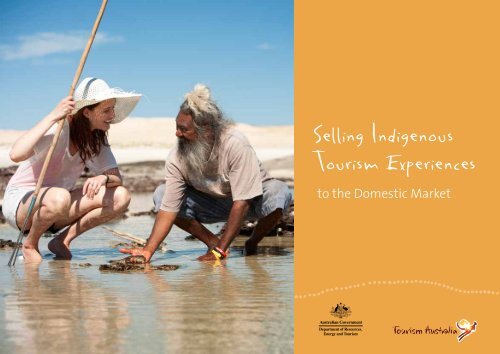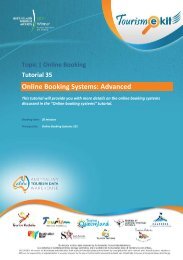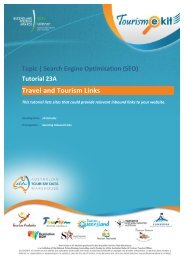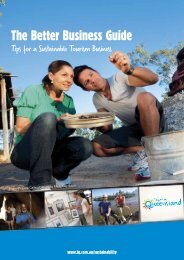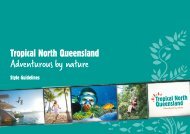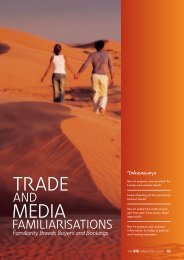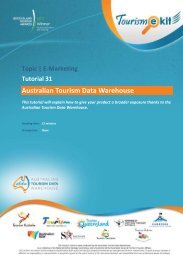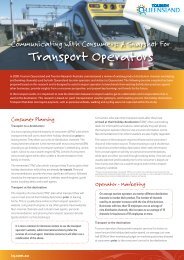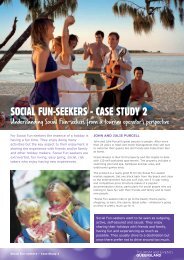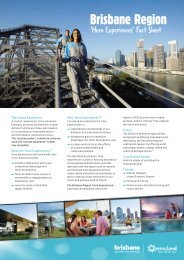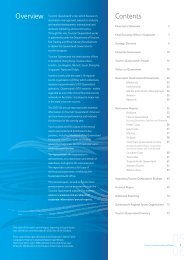Selling Indigenous Tourism Experiences to the Domestic Market
Selling Indigenous Tourism Experiences to the Domestic Market
Selling Indigenous Tourism Experiences to the Domestic Market
Create successful ePaper yourself
Turn your PDF publications into a flip-book with our unique Google optimized e-Paper software.
<strong>Selling</strong> <strong>Indigenous</strong><br />
<strong>Tourism</strong> <strong>Experiences</strong><br />
<strong>to</strong> <strong>the</strong> <strong>Domestic</strong> <strong>Market</strong>
Introduction<br />
In 2009, <strong>Tourism</strong> Australia and <strong>the</strong> Department of Resources, Energy<br />
and <strong>Tourism</strong> (RET) commissioned Jones Donald Strategy Partners <strong>to</strong><br />
undertake research <strong>to</strong> better understand what <strong>the</strong> domestic market<br />
thinks about <strong>Indigenous</strong> <strong>to</strong>urism experiences.<br />
The key finding was that <strong>Indigenous</strong> <strong>to</strong>urism was behind o<strong>the</strong>r<br />
Australian experiences, such as beach holidays and city breaks, in<br />
both appeal and participation, due <strong>to</strong> its limited ability <strong>to</strong> satisfy<br />
<strong>the</strong> key domestic holiday needs of refreshment and indulgence.<br />
For example most Australians go on holiday locally for a chance <strong>to</strong><br />
relax and unwind, which most Australians perceive as best done at<br />
<strong>the</strong> beach. <strong>Indigenous</strong> <strong>to</strong>urism activities however are perceived as<br />
being more intensive and whilst <strong>the</strong>y might be rewarding, <strong>the</strong>y take<br />
substatintal time and effort.<br />
However, older Australians (with children<br />
no longer living at home), and families<br />
with older children were more likely <strong>to</strong> find<br />
<strong>Indigenous</strong> experiences appealing,<br />
as <strong>the</strong>y like <strong>the</strong> learning aspect.<br />
The main reason that domestic <strong>to</strong>urists are<br />
generally not participating in <strong>Indigenous</strong><br />
<strong>to</strong>urism experiences is that Australian<br />
holidays are primarily considered an<br />
opportunity for fun and relaxation. Whilst<br />
<strong>the</strong>y don’t dislike <strong>Indigenous</strong> activities, a<br />
perception exists that <strong>the</strong> holiday would<br />
not be enjoyable and refreshing. Fur<strong>the</strong>r,<br />
most Australians are very familiar with<br />
stereotypical <strong>Indigenous</strong> experiences such as<br />
boomerang throwing and <strong>the</strong> corroboree, and<br />
thus <strong>the</strong>se experiences are often perceived <strong>to</strong><br />
be mostly inau<strong>the</strong>ntic, clichéd and designed<br />
for <strong>the</strong> international <strong>to</strong>urist market.<br />
While participation is currently low, <strong>the</strong><br />
good news is that Australian audiences<br />
respond positively when <strong>to</strong>ld about <strong>the</strong><br />
amazing things <strong>the</strong>y are able <strong>to</strong> do as part<br />
of an <strong>Indigenous</strong> experience. Thus it can be<br />
concluded that, although <strong>the</strong>re was initially<br />
limited enthusiasm for <strong>Indigenous</strong> <strong>to</strong>urism,<br />
a level of demand exists and Australian’s will<br />
participate if <strong>the</strong>y can be convinced of <strong>the</strong><br />
quality of <strong>the</strong> experience.<br />
To follow is a summary of <strong>the</strong> key findings<br />
from <strong>the</strong> research <strong>to</strong> help <strong>Indigenous</strong><br />
<strong>to</strong>urism opera<strong>to</strong>rs <strong>to</strong> understand<br />
domestic <strong>to</strong>urists, <strong>the</strong>ir motivations and<br />
<strong>the</strong>ir perceptions of <strong>Indigenous</strong> <strong>to</strong>urism<br />
experiences.<br />
<strong>Selling</strong> <strong>Indigenous</strong> <strong>Tourism</strong> <strong>Experiences</strong> <strong>to</strong> <strong>the</strong> <strong>Domestic</strong> <strong>Market</strong><br />
2
Perception Versus Fact<br />
The information contained in this document is not <strong>the</strong> opinion of<br />
<strong>Tourism</strong> Australia or RET, its staff or contrac<strong>to</strong>rs. It summarises <strong>the</strong><br />
opinions of a wide cross section of domestic <strong>to</strong>urism participants<br />
who were interviewed as part of an <strong>Indigenous</strong> focussed domestic<br />
<strong>to</strong>urism research project.<br />
It is important <strong>to</strong> understand that <strong>the</strong>se findings reflect <strong>the</strong><br />
perceptions and opinions held by potential cus<strong>to</strong>mers and this<br />
information should be considered when developing and marketing<br />
<strong>to</strong>urism products in order <strong>to</strong> attract <strong>the</strong> domestic <strong>to</strong>urism market.<br />
WHY TARGET DOMESTIC VISITORS<br />
<strong>Tourism</strong> Research Australia found that <strong>the</strong><br />
domestic market represented 71% of all<br />
<strong>Indigenous</strong> <strong>to</strong>urism visi<strong>to</strong>rs in Australia in<br />
2009. Most destinations in Australia receive<br />
significantly higher numbers of domestic<br />
visi<strong>to</strong>rs than international visi<strong>to</strong>rs, as such<br />
many <strong>Indigenous</strong> <strong>to</strong>urism businesses need<br />
<strong>to</strong> also appeal <strong>to</strong> <strong>the</strong> domestic market<br />
<strong>to</strong> grow <strong>the</strong>ir visitation and ensure long<br />
term profitability. For fur<strong>the</strong>r information<br />
on domestic participation in <strong>Indigenous</strong><br />
<strong>to</strong>urism, please read <strong>Tourism</strong> Research<br />
Australia’s <strong>Indigenous</strong> <strong>Tourism</strong> in Australia:<br />
Profiling <strong>the</strong> <strong>Domestic</strong> <strong>Market</strong> report.<br />
WHO SHOULD I BE TARGETING?<br />
Older Australians (with children no longer<br />
living at home), and families with older<br />
children were more likely <strong>to</strong> find <strong>Indigenous</strong><br />
experiences appealing as <strong>the</strong>y are more<br />
interested in learning.<br />
<strong>Tourism</strong> Research Australia has also<br />
found that <strong>the</strong>re is an opportunity for<br />
<strong>Indigenous</strong> <strong>to</strong>urism opera<strong>to</strong>rs <strong>to</strong> leverage<br />
off <strong>the</strong> convention and conference market.<br />
People on business meeting excursions<br />
were one group identified in <strong>the</strong> research<br />
that while <strong>the</strong>y don’t participate in many<br />
<strong>Indigenous</strong> <strong>to</strong>urism activities, <strong>the</strong>re is a real<br />
opportunity <strong>to</strong> use <strong>the</strong>se familiarisations/<br />
field trips <strong>to</strong> create an interest and desire <strong>to</strong><br />
engage in an <strong>Indigenous</strong> <strong>to</strong>urism experience<br />
in future personal travels.<br />
<strong>Selling</strong> <strong>Indigenous</strong> <strong>Tourism</strong> <strong>Experiences</strong> <strong>to</strong> <strong>the</strong> <strong>Domestic</strong> <strong>Market</strong><br />
3
WHAT ARE DOMESTIC TOURISTS LOOKING FOR?<br />
<strong>Domestic</strong> and International visi<strong>to</strong>rs each have<br />
very unique motivations and aspirations which<br />
affect <strong>the</strong>ir purchasing decisions.<br />
> > Australian <strong>to</strong>urists are primarily<br />
looking for fun and pampering in <strong>the</strong>ir<br />
holiday choices.<br />
> > <strong>Experiences</strong> which portray <strong>the</strong><br />
<strong>Indigenous</strong> cultural element as an<br />
addition <strong>to</strong> an already appealing<br />
experience will be more attractive <strong>to</strong><br />
Australians, for example:<br />
−−<br />
A professionally run fishing trip is fun<br />
and relaxing, but with an <strong>Indigenous</strong><br />
guide who has local expertise it<br />
becomes even more attractive<br />
−−<br />
A stay at a quality eco <strong>to</strong>urism<br />
facility can be more appealing with<br />
<strong>the</strong> offering of cultural dinners or<br />
interpretive <strong>to</strong>urs<br />
−−<br />
A knowledgeable <strong>Indigenous</strong> guide<br />
can add value <strong>to</strong> a <strong>to</strong>ur which includes<br />
a number of iconic landmarks and<br />
destinations where people really want<br />
<strong>to</strong> go <strong>to</strong><br />
> > People like <strong>to</strong> learn and ‘get <strong>the</strong>ir hands<br />
dirty’ so opera<strong>to</strong>rs should highlight both<br />
informative and hands on elements of<br />
<strong>the</strong>ir experience.<br />
> > Many <strong>to</strong>urists feel that <strong>Indigenous</strong><br />
activities are remote, can be<br />
uncomfortable and sometimes<br />
dangerous. Images and text should<br />
communicate wherever possible,<br />
<strong>the</strong> safety, comfort, consistency and<br />
professionalism of <strong>the</strong>ir product and that<br />
it is in an easily accessible location.<br />
> > Fun (fishing/hunting, bush tucker,<br />
s<strong>to</strong>ries), variety of activities and learning<br />
increases appeal, as does portraying <strong>the</strong><br />
experience with Australia’s beautiful<br />
scenery in <strong>the</strong> background<br />
WHAT SHOULD I AVOID?<br />
> > Australian’s generally want <strong>to</strong> <strong>to</strong>uch<br />
feel and taste <strong>the</strong>ir experiences, as<br />
such it is important that we do not<br />
portray (through images or text) passive<br />
activities where people are primarily<br />
watching.<br />
> > <strong>Domestic</strong> <strong>to</strong>urists want <strong>to</strong> see people<br />
interacting and being engaged in <strong>the</strong><br />
activity, <strong>the</strong>y want <strong>to</strong> be ‘shown how’<br />
and <strong>the</strong>n allowed <strong>to</strong> do it <strong>the</strong>mselves (eg<br />
catching a fish ra<strong>the</strong>r than watching a<br />
demonstration).<br />
> > Most Australians have thrown a<br />
boomerang or watched a corroboree, it is<br />
important when marketing <strong>to</strong> domestic<br />
<strong>to</strong>urists <strong>to</strong> focus on activities that are<br />
new and unique.<br />
“<strong>Experiences</strong> which portray <strong>the</strong><br />
<strong>Indigenous</strong> cultural element as an addition<br />
<strong>to</strong> an already appealing experience will<br />
be more attractive <strong>to</strong> Australians”<br />
4 <strong>Selling</strong> <strong>Indigenous</strong> <strong>Tourism</strong> <strong>Experiences</strong> <strong>to</strong> <strong>the</strong> <strong>Domestic</strong> <strong>Market</strong>
Guidance For The Development Of <strong>Indigenous</strong> Product<br />
Guidance For Promotion Of <strong>Indigenous</strong> Product<br />
The promotion of <strong>Indigenous</strong> product<br />
requires an approach that has broad appeal.<br />
All promotional material should highlight<br />
where possible;<br />
> > Safety and comfort<br />
> > Consistency and professionalism<br />
> > Ease of access<br />
Research has shown that Australians prefer a<br />
fun, hands on experience. It is <strong>the</strong> combination<br />
of enjoyment, variety of activity and learning<br />
that increases <strong>the</strong> appeal of <strong>Indigenous</strong><br />
<strong>to</strong>urism experiences. Thus <strong>the</strong> following types<br />
of elements should be highlighted:<br />
> > Fun – entertaining activities (fishing/<br />
hunting, coastal exploration, eco, bush<br />
tucker, s<strong>to</strong>ries)<br />
RELATIVE APPEAL OF INDIGENOUS TOURISM EXPERIENCES<br />
Coastal/fishing <strong>to</strong>ur<br />
Short Tour - urban/city<br />
Self contained eco/luxury accommodation<br />
Hot springs/massage/healing retreat<br />
Short <strong>to</strong>ur - country<br />
Performance/<strong>the</strong>atre<br />
Longer <strong>to</strong>ur - outback/remote/4WD<br />
Restaurant<br />
Stay with an <strong>Indigenous</strong> community<br />
Learn <strong>to</strong> create arts and crafts/workshop<br />
See arts and crafts being created/gallery<br />
Cultural centre<br />
Volunteer project/nature<br />
Adventure <strong>to</strong>ur<br />
Purchase art/retail<br />
> > Learning – enrichment and education<br />
(his<strong>to</strong>ry, tradition, different perspectives)<br />
Adding an <strong>Indigenous</strong> perspective <strong>to</strong> an<br />
already appealing experience will make<br />
a good experience better. For example, a<br />
wilderness cruise that includes an au<strong>the</strong>ntic<br />
<strong>Indigenous</strong> interpretation element will have a<br />
competitive advantage over one that doesn’t.<br />
Though <strong>the</strong> experience itself needs <strong>to</strong> be<br />
attractive, in addition <strong>to</strong> <strong>the</strong> cultural appeal.<br />
<strong>Experiences</strong> which held <strong>the</strong> most appeal can<br />
be seen in <strong>the</strong> graph below:<br />
(% Respondents)<br />
9<br />
39 52<br />
11<br />
44 45<br />
15 40 45<br />
16 39 45<br />
16 41 43<br />
18 40 42<br />
22 38 39<br />
13 48 38<br />
23 41 35<br />
27 37 35<br />
25 42 33<br />
19 49 32<br />
24 43 32<br />
30 37 32<br />
28 51 21<br />
Low<br />
Medium<br />
High<br />
It is important that you understand who<br />
you are talking <strong>to</strong> with your marketing so<br />
you can tailor your marketing message<br />
(text and pho<strong>to</strong>s) <strong>to</strong> meet <strong>the</strong>ir needs.<br />
Broadly speaking:<br />
> > Australian travellers will be engaged<br />
by experiences that are promoted<br />
as offering interactive learning in<br />
an au<strong>the</strong>ntic outdoor environment.<br />
Highlight key <strong>the</strong>mes: Getting your<br />
hands dirty, <strong>to</strong>uching, tasting, feeling,<br />
fresh air.<br />
> > <strong>Experiences</strong> that are unique and<br />
incorporate natural elements such as<br />
water, earth, fire and rainforest hold<br />
broad appeal.<br />
> > Fur<strong>the</strong>rmore, <strong>the</strong>re are some segment<br />
differences that should also be noted;<br />
> > Young adults respond best <strong>to</strong><br />
opportunities for group interaction and<br />
involvement, satisfying this segments<br />
needs for fun and bonding - show groups<br />
having fun and interacting.<br />
> > Adults without kids favour experiences<br />
that are more intimate and allow direct<br />
engagement in a dynamic setting - show<br />
smaller groups, timeout for couples,<br />
spirit of adventure.<br />
> > Families with younger children seek<br />
outdoor, interactive experiences with a<br />
variety of activities, whilst those with<br />
older children prefer an additional<br />
learning element - show a safe<br />
environment for fun and learning.<br />
> > Older adults that are still working but<br />
with no kids at home are motivated<br />
by opportunities <strong>to</strong> connect with<br />
<strong>Indigenous</strong> people in a natural<br />
environment - show active participation<br />
in activities, where <strong>the</strong>y can feel <strong>the</strong>y are<br />
still young enough <strong>to</strong> be hands on.<br />
> > Retirees require a safe and comfortable<br />
environment, as well as opportunities<br />
for meeting o<strong>the</strong>r travellers - show<br />
social interaction in a comfortable and<br />
learning environment.<br />
COMMUNICATION CHANNELS<br />
<strong>Indigenous</strong> <strong>to</strong>urism businesses need <strong>to</strong> have<br />
a great online presence. <strong>Tourism</strong> Research<br />
Australia found that more than half of all<br />
domestic <strong>Indigenous</strong> <strong>to</strong>urism visi<strong>to</strong>rs use <strong>the</strong><br />
internet for trip planning.<br />
A large share of visi<strong>to</strong>rs used travel books and<br />
brochures <strong>to</strong> find information about <strong>the</strong>ir<br />
trip and <strong>the</strong>y also relied upon word of mouth<br />
recommendations. This highlights <strong>the</strong> need<br />
for consistency in product quality and delivery.<br />
Note: Appeal rated on 0-10 scale. low (0-4), Mid (5-7), High (8-10)<br />
Base: All respondents who saw concepts. A1(n=217), A2(n=233), AC1(n=308), AC2(n=219), AC3(n=270), CC1(n=322),<br />
PA1(n=322), T1(n=259), T2(n=231), T3(n=227), T4(n=227), T5(n=238), O1(n=322), O2(n=267), V1(n=318)<br />
Source: Q3.1 - Using a scale of 0 <strong>to</strong> 10, please indicate how interested you would be in having this experience.<br />
5 <strong>Selling</strong> <strong>Indigenous</strong> <strong>Tourism</strong> <strong>Experiences</strong> <strong>to</strong> <strong>the</strong> <strong>Domestic</strong> <strong>Market</strong>
IMAGES<br />
Images that are found <strong>to</strong> be most appealing are those that take<br />
consumers outside <strong>the</strong>ir everyday experiences <strong>to</strong> provide a unique<br />
perspective. The inclusion of an <strong>Indigenous</strong> guide, s<strong>to</strong>ry teller or host<br />
increases <strong>the</strong> au<strong>the</strong>nticity of <strong>the</strong> experience and adds credibility <strong>to</strong> <strong>the</strong><br />
product. Image types that are generally favoured are shown below;<br />
Images which domestic <strong>to</strong>urists felt showed clichéd, passive or<br />
inau<strong>the</strong>ntic depictions of <strong>Indigenous</strong> experiences did not appeal.<br />
6 <strong>Selling</strong> <strong>Indigenous</strong> <strong>Tourism</strong> <strong>Experiences</strong> <strong>to</strong> <strong>the</strong> <strong>Domestic</strong> <strong>Market</strong>
MESSAGES<br />
The language used when communicating with domestic<br />
<strong>to</strong>urists should stress <strong>the</strong> active, enriching and fun elements<br />
of <strong>Indigenous</strong> experiences.<br />
WORDS TO USE<br />
−−<br />
Interactive<br />
−−<br />
Inviting<br />
−−<br />
Dynamic<br />
−−<br />
Relaxed<br />
−−<br />
Fun<br />
−−<br />
Bright<br />
−−<br />
Colourful<br />
−−<br />
Intriguing<br />
−−<br />
Inspiring<br />
−−<br />
Entertaining<br />
−−<br />
Active<br />
−−<br />
Well organised<br />
MESSAGES TO AVOID<br />
Some Australian’s perceive that <strong>Indigenous</strong> experiences<br />
will involve a level of discomfort (getting hot, dusty<br />
or roughing it). You need <strong>to</strong> be careful when selecting<br />
images or writing descriptions <strong>to</strong> make sure negative<br />
perceptions are addressed, for example “Enjoy a<br />
<strong>to</strong>ur of <strong>the</strong> spectacular ranges in our comfortable<br />
air-conditioned bus with gourmet food supplied and<br />
overnight accommodation provided in a well appointed<br />
four star hotel.”<br />
Avoid descriptions that indicate a passive experience<br />
for example, instead of writing “watch a display of<br />
Aboriginal dancing” try “enjoy an entertaining evening<br />
of music and celebration, where you will be invited <strong>to</strong><br />
join in and learn how <strong>to</strong> do an Aboriginal dance.”<br />
7 <strong>Selling</strong> <strong>Indigenous</strong> <strong>Tourism</strong> <strong>Experiences</strong> <strong>to</strong> <strong>the</strong> <strong>Domestic</strong> <strong>Market</strong>


